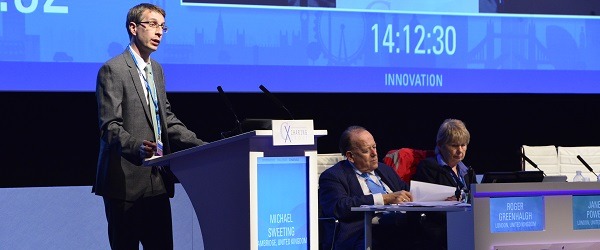
A “podium first” presentation of very long-term follow-up data from the EVAR 2 trials suggests that endovascular aneurysm repair (EVAR) fails to improve all-cause mortality, but reduces aneurysm-related mortality compared to no treatment in abdominal aortic aneurysm patients who are physically ineligible for open repair. The data were presented yesterday at CX and prompted a discussion on the dilemma of whether to offer, or withhold, EVAR in this group of frail patients in the light of these findings. The panel discussion then prompted a spontaneous show of hands in which delegates backed the idea of adopting a model of shared decision-making with frail patients who are in poor health when discussing EVAR or no treatment.
Introducing the trial, Roger Greenhalgh, London, UK, chairman of the CX Programme Organising Board said: “EVAR 2 remains the sole randomised trial to identify whether EVAR reduces mortality rates in patients ineligible for open repair. It used a prescient ‘traffic light’ system in the 1990s that utilised cardiac, respiratory and renal criteria to determine patient fitness and eligibility for enrolment in the EVAR trials. ‘Red light’ patients were those who had myocardial infarction, onset of angina, unstable angina at night or at rest within the last three months. These were not enrolled in either EVAR 2 or EVAR 1, but were helped to optimise their fitness. EVAR 2 included ‘amber light’ patients with a past history of myocardial infarction, revascularisation, angina, severe heart valve disease, arrhythmia, congestive cardiac failure or FEV1 less than 1L or creatinine more than 200μmol/L. ‘Green light’ patients were those who had none of the above comorbidities and these were eligible for enrolment in the EVAR 1 trial.”
Michael Sweeting, Cambridge, UK, speaking on behalf of the EVAR 2 trial investigators, said: “The EVAR 2 randomised controlled trial was instigated to identify whether EVAR improves survival in patients who are unfit for open repair of aortic aneurysm, compared with no intervention.”
The investigators randomised 404 patients from 33 UK centres between September 1999 and August 2004. Included patients were over 60 years of age, whose abdominal aortic aneurysms were 5.5cm or greater in diameter. One hundred and ninety seven patients underwent EVAR and 207 received no intervention. The mean age of patients enrolled in EVAR 2 was 77 years and 86% were male. The mean aneurysm diameter was 6.7cm.
The period of very long follow-up beyond eight years went from September 2009 until June 2015 and the trial obtained data from the 20% of patients who were alive at this point. “These were the most physically fit of all patients enrolled, ie. those likely to most benefit from EVAR. We reminded centres to continue regular follow-up, including those with lapsed follow-up. The complications and reinterventions were recorded by trial centres and there was record-linkage until June 2015 with mortality records. The causes of death were adjudicated by the Trial Endpoint Committee,” Sweeting noted.
Summarising the main results, Sweeting said: “There was a high 30-day operative mortality in the EVAR group. Additionally, half the number of aneurysm-related deaths took place in the EVAR group over full follow-up. There was no overall survival benefit.” Additionally, the trial also found that the poor health status of the patients enrolled meant that there was a limited life expectancy of just over four years in both groups with patients dying of coronary heart disease, cancer and respiratory deaths, with more deaths in the group receiving EVAR, than no treatment.
However, noted Sweeting, over 30% of patients in the no intervention group chose to have an elective EVAR in the follow-up period. “Patient fitness was better in the select group that underwent elective EVAR in the no intervention vs. the EVAR group,” he said.
The triallists used the data to identify predictors of long-term survival. “Patients in the trial who survived more than eight years were on average younger; had a higher mean body mass index; a higher mean predicted FEV1 percentage and higher mean estimated glomerular filtration rate (eGFR). There was, however, no evidence of an overall survival benefit from EVAR for any particular subgroup,” said Sweeting.
Limitations and strengths
Greenhalgh then put the limitations of the trial’s methodology into perspective: “Many patients in the ‘no intervention’ group crossed over to receive endovascular treatment. Also, there is only a small proportion of patients alive after eight years. The devices of today and epidural anaesthesia (which was not given in nearly 50% of patients) could produce an entirely different trial result. It is likely that today, reinterventions would be carried out better,” he said.
He also emphasised that the loss to follow-up reduced the reporting of complications, re-interventions and abdominal aortic aneurysm-related mortality. “Patient frailty may have prevented reintervention,” he added. The strengths of the trial are that there was a complete follow-up for total mortality, and insight from supporting causal analysis. “Essentially, the EVAR 2 trial highlights high patient comorbidities and that the all-cause mortality is the driver,” Greenhalgh concluded.
Divided audience voting followed the statement “15-year EVAR 2 results influence me to offer EVAR for highly comorbid patients” with 51% voting “no”.
In the discussion, the audience heard that a factor that could influence the decision to offer EVAR, or not, would be whether it improved the quality of life for patients, even if it did not prolong life. Further discussion points touched on whether there was a cut-off age or aneurysm size, on which there are currently no data.
Greenhalgh, on behalf of the investigators, recognised the “tremendous input” from the participating centres and the support of the Vascular Society of Great Britain and Ireland (VSGBI) and the British Society of Interventional Radiology (BSIR) throughout the trial.













